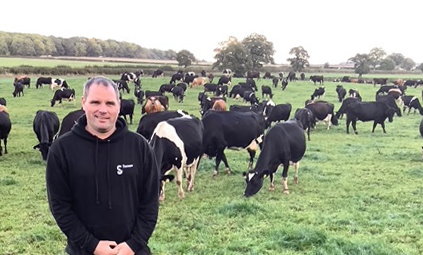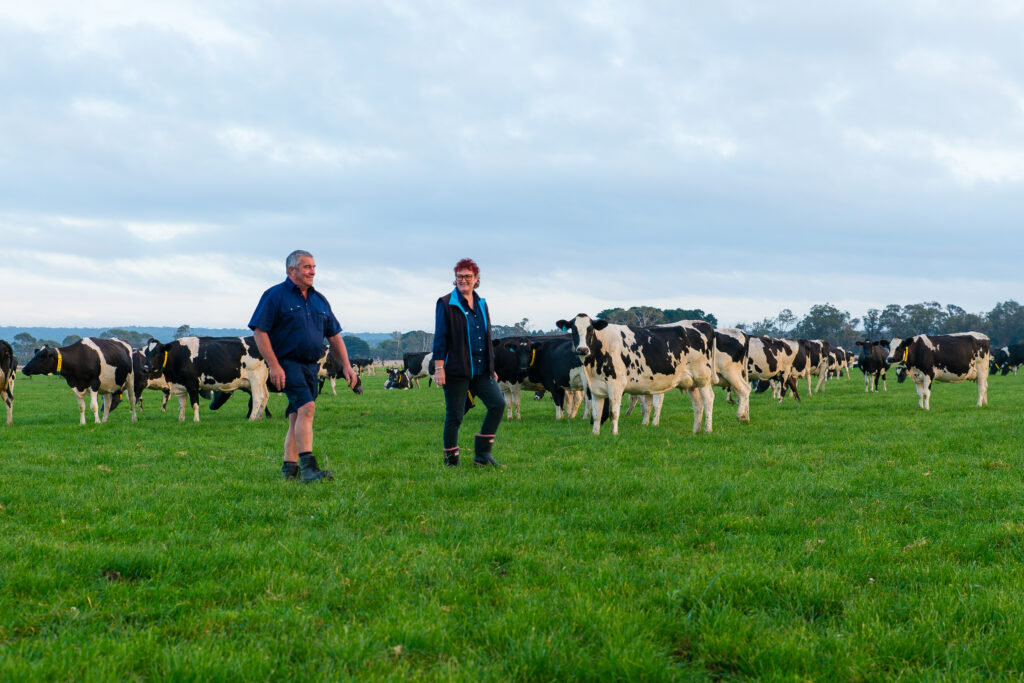UK dairy farmer Breiffini Daly puts most of his success down to using top New Zealand AI technicians, quality semen and identifying bulling heats efficiently.
 “I’m passionate about dairy cows and grass,” says Daly, who looks after 1500 cows and 1000 youngstock on the Sansaw Estate at Sheepcotes, Hadnall on the outskirts of Shrewsbury in the UK.
“I’m passionate about dairy cows and grass,” says Daly, who looks after 1500 cows and 1000 youngstock on the Sansaw Estate at Sheepcotes, Hadnall on the outskirts of Shrewsbury in the UK.
Working closely with LIC he’s had a great year with impressive mating figures for both cows and heifers and puts most of his success down to using top New Zealand AI technicians, quality semen and identifying bulling heats efficiently.
“I can still do better,” he says. “I always strive to do the best, so while I am happy with these results, I know I can set more stringent goals and reach them.”
The Sheepcotes farm is a total of 800ha and carries a high stocking rate of a total of 2500 animals and 40 bulls. There’s a 500ha milking platform and a 300ha support block used for rearing the youngstock and for cutting silage.
Almost all the farm is down to grass, with approximately 40ha of fodder beet for winter grazing, up to 25ha on the support block and 15ha on the grazing platform.
Fodder beet is used to graze the dry cows over the winter, and to add to the ration of the 750 cows outwintered each year.
“We invested in a new cubicle building for 800 cows a couple of years back, so the herd is split into two with those animals housed and the remainder outwintered.”
In his first year of running Sansaw Estate, some 1100 heifers were imported from Ireland also UK and wales/Scotland united nations we put together to grow the herd. Since then, apart from one year when a different semen supplier was used (and resulted in bigger animals than Breiffni likes) he has stuck with LIC for all the herd’s genetics.

“My ideal cow is one that weighs about 500kgs and has a mixture of New Zealand Friesian Irish Friesian and Jersey,” he says. “Because of the layout of the farm they need to walk between 4 and 4.5kms a day from the parlour to the fields and back, so a smaller animal is vital.”
His aim is to get liveweight and milk solids production the same, or even better, so with a 500kgs cow is looking for 500kgs milk solids. At the moment his solids’ yield is around 440kgs with a protein level of 3.8 and fat of 5. “There’s room for improvement here,” he admits.
The grazing platform is all paddock-based and with a total of some 160 paddocks, each approximately 6ha each, there’s always plenty of fencing to be done. The paddocks are grazed with either 12 or 36 hour breaks depending on covers and while the farm takes two to three big cuts of silage for the clamps each May and June, a further 3000 large round bales are made for the outwintered herd and youngstock.
A brand new 70 bale Waikato rotary was installed in 2012 and with more currently tenanted land coming back in hand in the near future, there are already more plans for future investment that could include a satellite unit on the edge of the existing land area.
“I’d like to get up to 1800 milkers,” he says, “but that will only be possible with more land. So we’ll wait and see.”
Fertility a top priority
Fertility is top of the traits Breiffni seeks when looking at the genetics of his herd. Asked to quantify that, he says he would select 60% for fertility and 40% for yield. Overall yield is around 5000 litres/cow and as he’s on an Arla 360 liquid contract, he’s currently getting a return of 63p/litre, one of the best prices on offer at the moment.
Other traits include good feet and legs and he plans to look at udder health and teat alignment more in the future.
As the herd is spring calving, breeding starts in the last week of April, the last Monday, with the heifers, and in the first week of May, again on a Monday, with the cows.
This year he had 1400 cows eligible for mating and carried out a total of 2037 inseminations between May 2 and June 12. His three-week submission rate was 92% against his target of 90%. His non-return rate was 65%, 5% below the industry target of 70% at six weeks.
Aged pregnancy diagnosis is by far the best tool for identifying in-calf and empty cows and the PD scanning results showed 75% of the cows at six weeks scanned in calf, and 87% of the heifers.
“With the cows our average insemination rate was just under 1.5 straws per cow,” he says. “While I believe the industry average is nearer 2, I would like to get this below 1.2 in the future. We want to be the best – that’s what we’re always striving to be.
“We use AI for the first six weeks and then the bulls will go in. I don’t concentrate too much on the six-week calving rate, I just want pregnancies.”
All cows are scanned in September and usually about 180, a bit over 10%, will end up being separated out as cull cows and fed up to go to market in the first week of November. “We should do better here and keep these numbers below 10%, I’d rather be closer to 6%.”
Of the 387 heifers, 361 were submitted with a total of 384 inseminations. The three-week submission rate was 97%, but always aiming higher, Breiffni says he wants this to increase to 100%.
He buys 1000 straws of sexed semen each year and uses this on all the heifers and 550 on the cows. “I think we’ve still got quite a lot to learn here and we are improving our results every year. Cow selection is key.”
This year he used 5 LIC bulls: Seifion Cardi, Trapeze, Hardcopy, Safari and Professional and used the short gestation Hereford bulls from Shrimptons Hill.
There’s a heavy reliance on grass at Sansaw Estate, and to an extent that, and forward buying through a buying group, is helping them to face the ever-increasing costs of fertiliser and feed.
“We do watch the markets and try to buy carefully,” he says. “We are looking at reducing fertiliser use, usually around 180kgs/ha across the farm. This year, we made more silage early on and, we went up to 190kgs/ha this year but next year would aim to be around 150kgs/ha.
“We’re moving towards this by stitching in clover and I must admit to doing a little experimenting in this area. It didn’t work so well last autumn, but we have gone a bit earlier this year and at the moment it looks better.”



